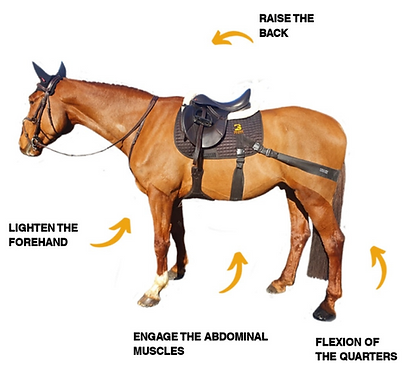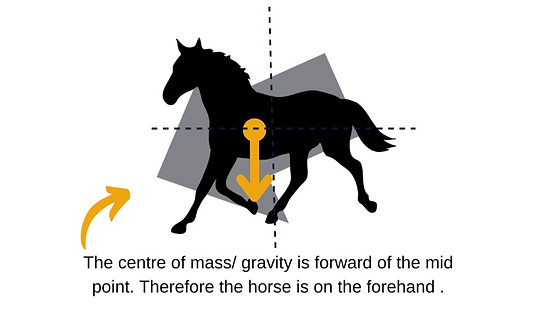How Do Equine Balance Bands Work?
Equine Balance Bands Saddle Pad System for Core Conditioning in Horses Explained.
Resistance band training increases body position awareness and encourages the development of key muscle groups that support the spine in the ridden horse.
The Equine Balance Bands System comprises of 2 unique latex-free resistance bands, specifically developed for equine use. They are fitted around the horse's hindquarters and abdomen and attach to a specially designed saddle pad, shaped to alleviate pressure points.

Use of the bands during training helps to activate the core muscles which stabilise the spinal column and promotes development of the top line musculature.
How It Works
Developing Proprioceptive Awareness
During movement the bands exert a continuous stimulus on the body, which is recognised by receptor cells in the skin. This induces a sensory response by the nervous system and encourages the horse to engage the 'rounding' muscles of the body as opposed to the extensor chain of muscles that are responsible for hollowing of the frame.

Engaging the core muscles such as the ileopsoas group (muscles that help flex the hip and haunches), and the abdominal muscles helps the back, pelvis and hind limb to achieve optimum function so that the horse can develop body strength, suppleness and stability.



The ileopsoas muscles act on the spine, pelvis and femur initiating flexion of the haunches.
The abdominal muscles act on the trunk and pelvis - helping to provide strength, support and stability as forces of motion are transmitted from limbs to torso and vice versa.
The abdominal band encourages the horse to engage the abdominal musculature which is particularly beneficial for horses with an inverted/ hollow posture. The hind quarter band encourages greater awareness of limb placement during movement which is particularly beneficial in cases of poor engagement or asymmetrical movement.
Who Created Equine Balance Bands?
Our Background Story

Christine Patterson - Co-founder of Equine Balance Bands "I am a retired Sports and Exercise Fitness Coach and my daughter is a BHS Equestrian Coach and Sports Massage Therapist in Ireland. Together we developed the product to help ex racehorses make the transition from racing to riding horses in order that they could be successfully rehomed and go on to have a happy and sound second career. Many of these horses had good temperaments and athletic ability but struggled with engagement, found it difficult to work over the back or were inclined to hold them selves in a tense or hollow outline. By incorporating the bands into a structured and progressive core conditioning program it seemed to help the horses to settle and figure out what was required of them. People began to notice the difference and enquire about the system. I think that using the bands also makes the handler more aware of how the horse uses his whole body, which is a positive step away from some of the more restrictive and commonly deployed training practices in equestrianism."
Equine Core Strength and Stability
The Importance of Preparing the Horse for Work Under Saddle
Core stability can be referred to the ability to recruit the deep muscles that connect the pelvic limbs and spine to produce quality and controlled movement. Increased core stability enhances the ability of the soft tissues to protect the spine from injury or re-injury.
In human fitness and therapy practise it is well recognised that if the core is weak then the other body parts may come under strain or suffer from over use. With the horse we can apply the same principles, plus there is an increased responsibility to condition and prepare the hose for its role in carrying the weight of the rider and developing balance in movement under saddle.

In addition, the modern lifestyle of both horse and rider can present challenges with regards to health and fitness. The domestic horse is subject to the confines of human intervention and routine. He is less active than a horse reared in a natural environment and reduced physical activity can lead to poor muscle tone and reduced functional soft tissue support. People are more conscious these days about animal welfare and well being and are keen to take proactive measures to maintain the health and soundness of their animals.

Remember that the horse evolved over hundreds of thousands of years into a free roaming, foraging, prey animal and it is only in more recent history that his existence became dependant upon his relation ship with mankind and his usefulness under saddle. An understanding of his natural inherent characteristics can help us to manage his lifestyle and training options in a considerate way and to make changes that compliment or improve his current condition.


The Natural Balance of the Horse
3 Key areas for Consideration in Overcoming Inherent Weakness…….
…..and Why Some Horses Require Extra Help
1. The Horse is Forehand Heavy - Horses naturally carry a greater proportion of weight (approximately 60%) through the front limbs. The natural tendency of the horse is to weight the forehand meaning greater stress on the fore limbs and joints. Conformation and previous training experience may effect the extent to which the horse relies upon his forehand for balance.

Training the horse to transfer excess weight from the forelegs to the hind quarters begins by encouraging each of the hind limbs to step further under the horse's centre of gravity.

This is not entirely straight forward as the horses hindquarters are wider than his shoulders. This combined with his inherent handedness (or preference to engage one side of the body over the other), can cause the horse to lean in, fall out or move crooked.

Understanding this and training for optimum balance and limb placement improves stride symmetry. By increasing awareness of how the hind limb functions and is positioned the horse becomes better able to support his own weight plus that of the rider in movement. Because the largest of the horse's muscles are located in the hind quarters we can positively influence muscle tone and function in this area, helping the horse to fully develop his athletic potential.
2. The Effect of Weight on the Back - The shape of the spine upon which the rider sits and from which the horse’s considerable gut is suspended should be given consideration. The orientation of the thoraco-lumbar curve is usually straight or slightly dorsally convex, however with the increased weight of a saddle and rider this orientation can become inverted (ventrally convex). The risk of a hollow posture and inverted spine can increase further when there is training related confusion, tension or anxiety. This is a weaker shape for supporting weight and continued exertion can lead to pain and soft tissue degeneration. Variables which may pre dispose the horse to adopt a hollow posture include age, genetics, previous training, saddle fit and the presence or lack of supporting musculature.

With regard to the role that the core muscles play in supporting the spinal column, the bow and string theory gives us a simple to understand analogy to explain how positive tension of the string (core muscles) can help the back to 'come up'.

3. The Increased Force that acts on the Body in Motion - If the horse is neither trained nor conditioned to carry the load appropriately, the musculoskeletal system will be subject to extra stress. Adopting an inappropriate balance may cause discomfort and show as resistance, bad behaviour or eventual lameness.
This means that the more demanding the work load the greater the stress and potentially the stronger the horse’s objection!
Preparatory Training
For Success, Soundness and Longevity
Preparatory training can help the horse to build the supporting musculature which will enable the horse to better adjust his balance whilst carrying a rider. Considerate and regular exercise that uses a range of stretching and suppling techniques to activate and engage the core can be incorporated into the work schedule with the aim of developing the top line, increasing proprioceptive awareness and strengthening the musculoskeletal system.

The result is a happier horse, better able to adjust to the demands placed upon him. This often shows as:
Improved performance
Increased tolerance to exercise
Development of the top line muscles
Preservation of soundness.
Find out More
Click a link below to view related content:
